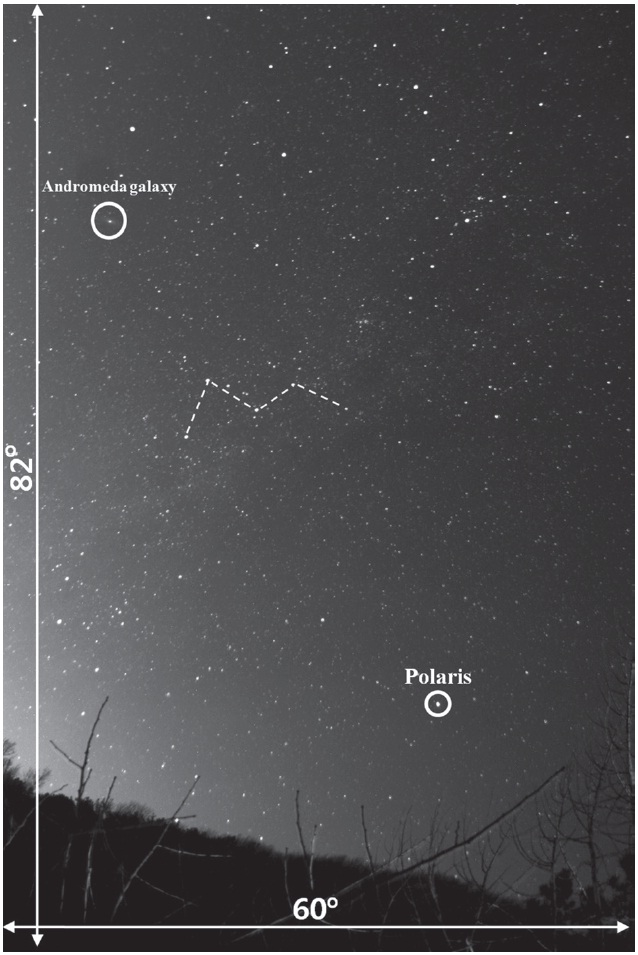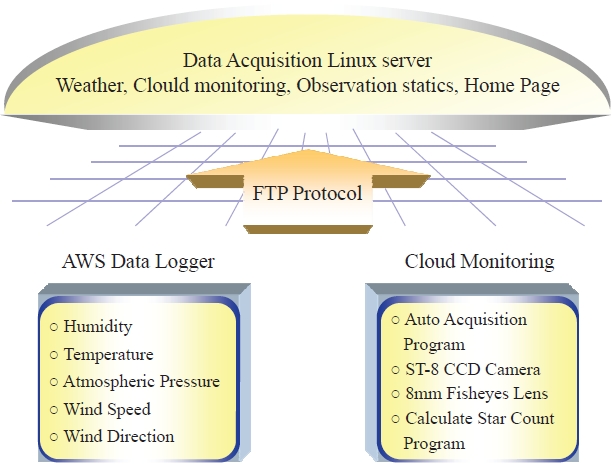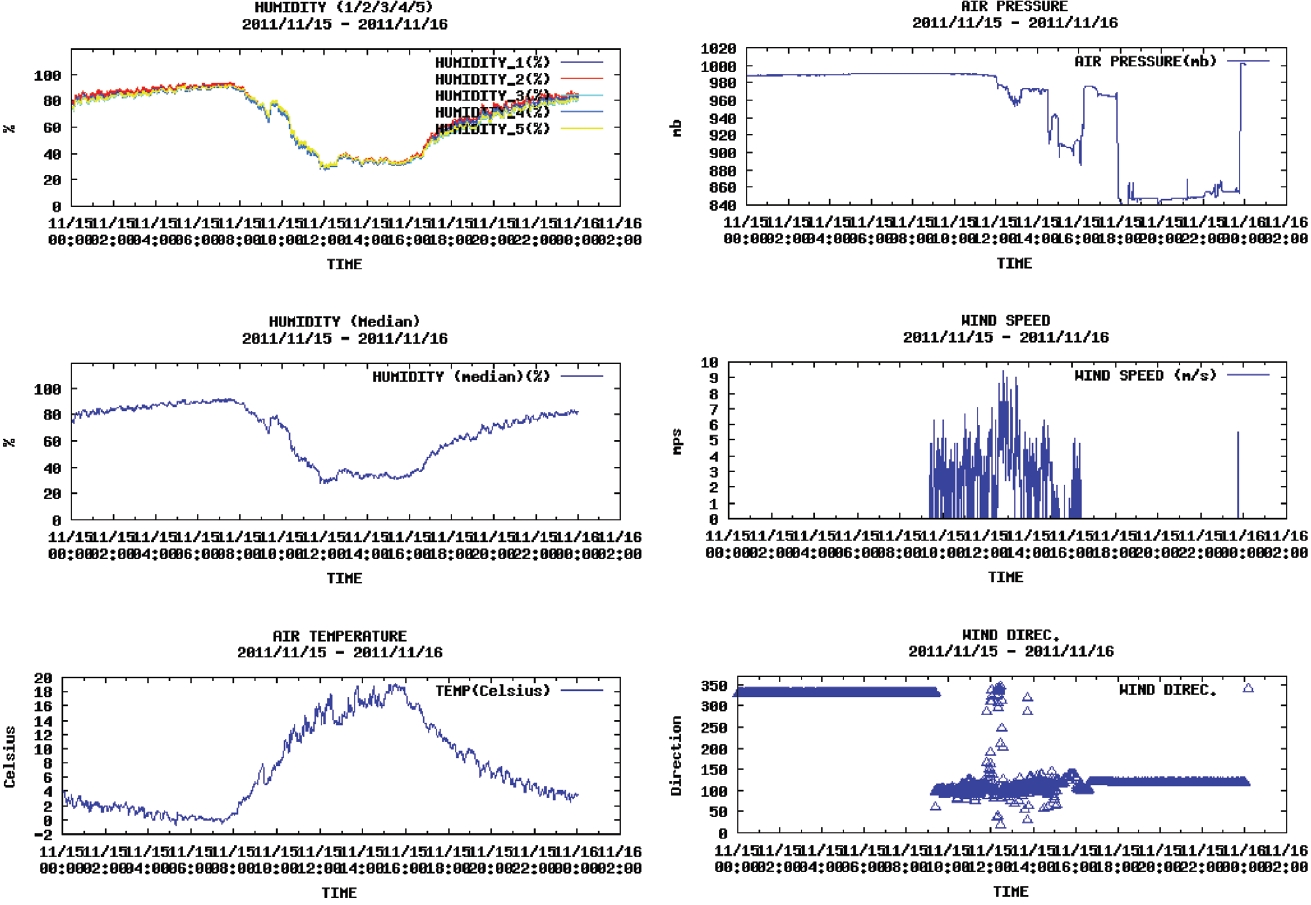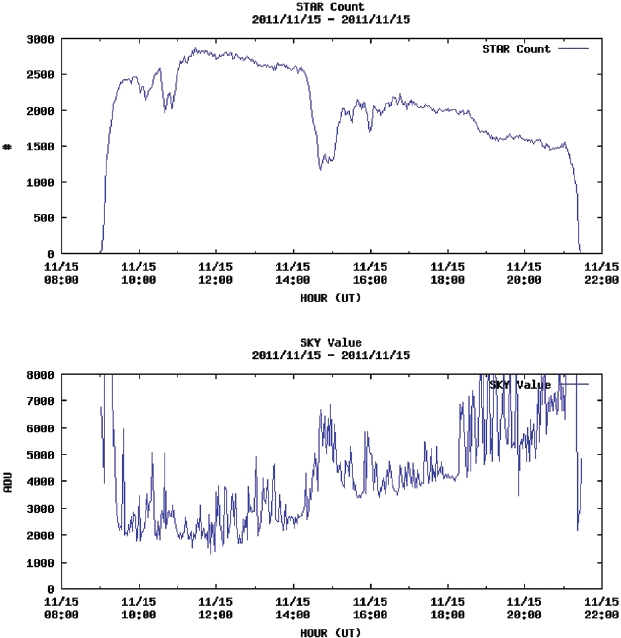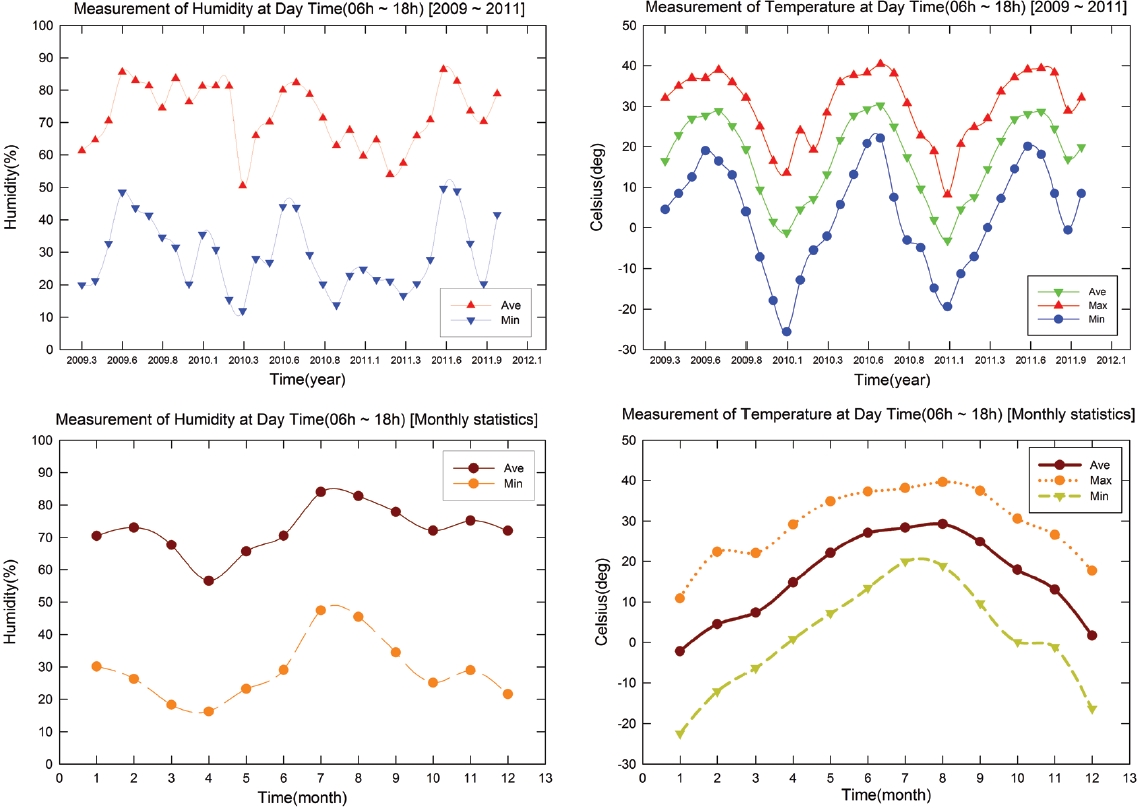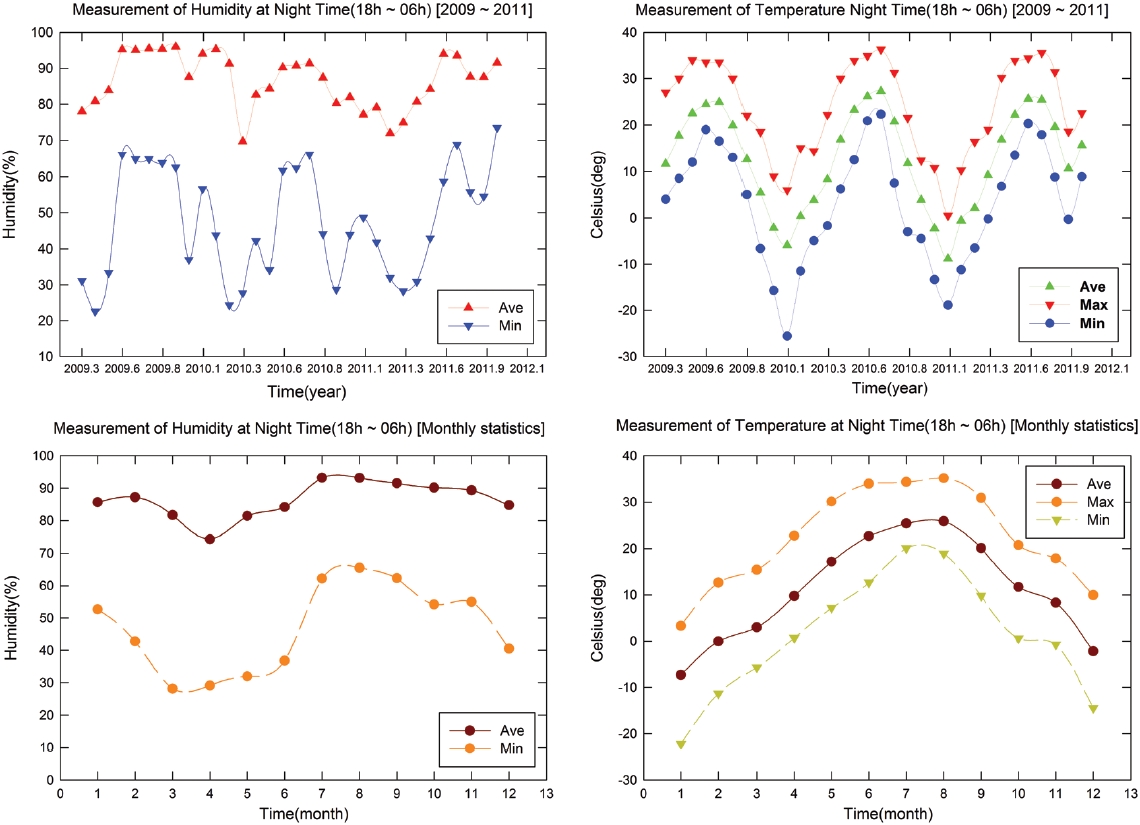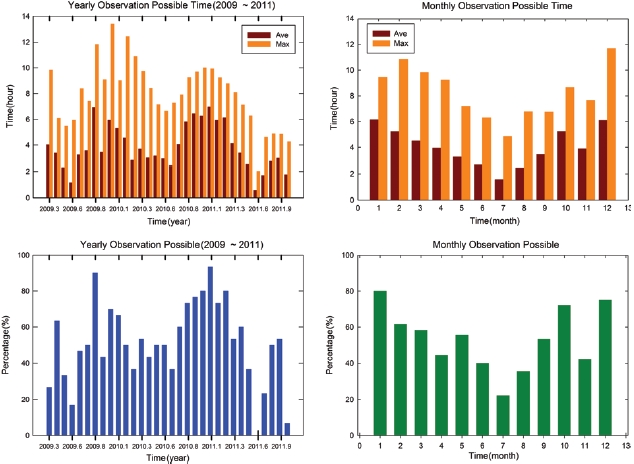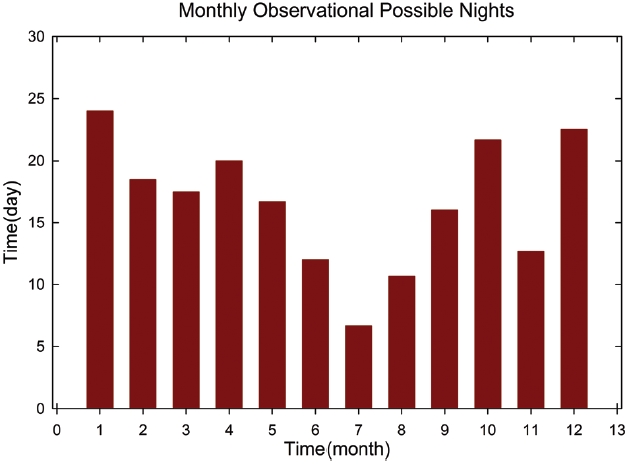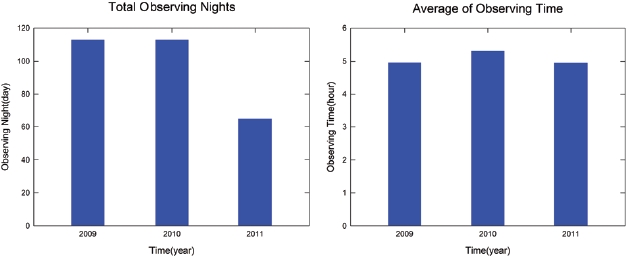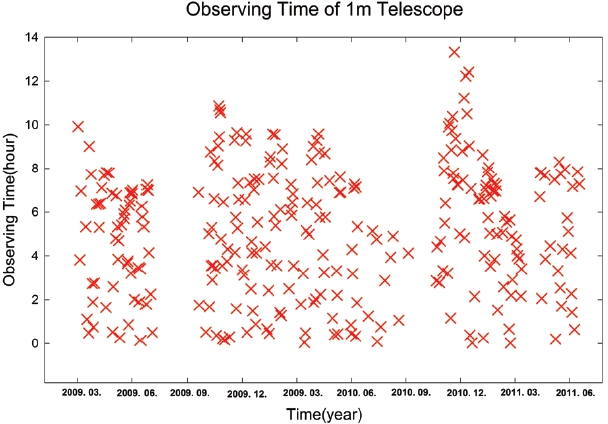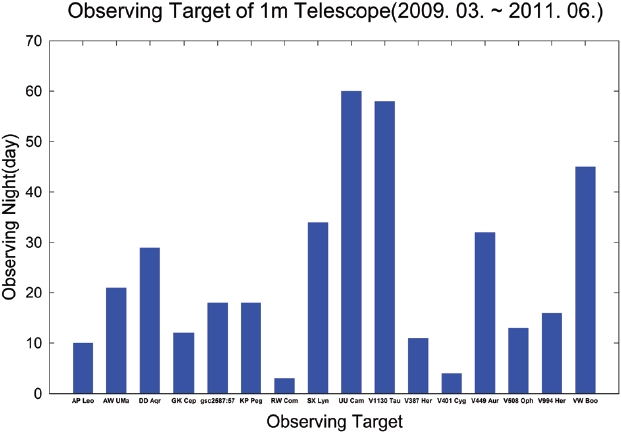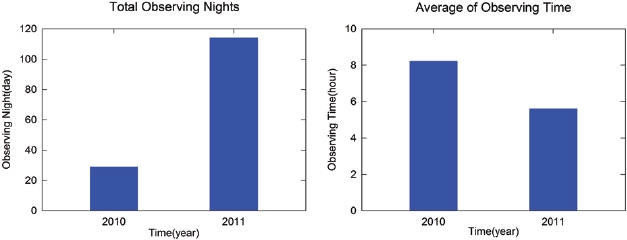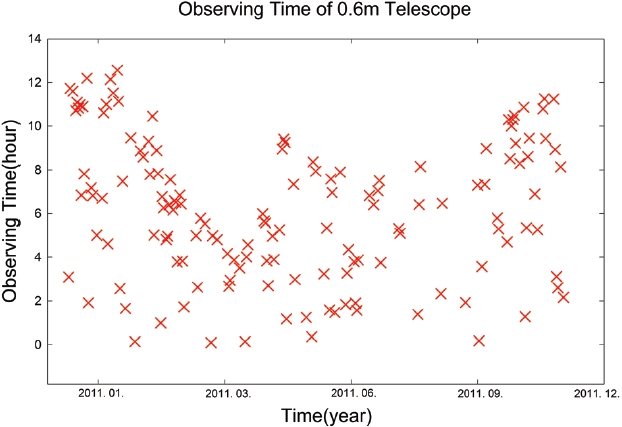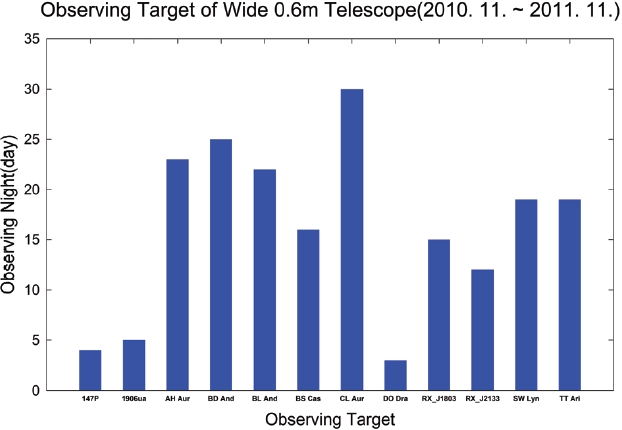



Astronomical Observations at Chungbuk National University Observatory (CBNUO) with an 1 m telescope have begun since April 2008, and Near-Earth Space Survey observations also have been started since November 2010, with a 0.6 m wide field telescope developed by Korea Astronomy and Space Science Institute. To improve observational efficiency, we developed a weather monitoring system enabling automatic monitoring for the weather conditions and checking the status of the observational circumstances, such as dome status. We hope this weather monitoring system can be helpful to more than 100 Korean domestic observatories, including public outreach facilities. In this paper, we present the statistic analysis of the weather conditions collected at CBNUO for 3 years (2009- 2011) and comparisons were made for clear nights between using only humidity data and both humidity and cloud data.
The 1 m telescope of Chungbuk National University Observatory (CBNUO) prepared for observation at the site of Moonbaek-myeon, Jincheon-gun, Chungbuk Province in April 2008 with new establishment of Euntan Branch University and started astronomical observation at that site (sea level 81 m, latitude: +36° 46′ 53″, longitude : 127° 28′ 31″ E).
Since its opening, the photometric observations for variable objects were mainly performed with the 1 m telescope, and additional facilities to measure the meteorological data such as cloud amount, were referred in the operation of observatory.
In addition, we participated in a research for Near Earth Object survey project (NEOPAT) performed by Korea Astronomy and Space Science Institute (KASI) (Yim et al. 2009), and as a result, in November 2010, we installed a 0.6 m wide field telescope developed by the KASI for experimental observation at CBNUO site provisionally, allowing us independent, or simultaneous observations using these two telescopes.
Many observatories measure the meteorological data including sky conditions for a long period of time, and release their data to astronomers for analysis of observational circumstances to improve the data quality, or other public use.
As an example, in case of Observationo del Roque de los Muchachos (ORM) astronomical observatory located at La Palma, the Canary Islands, it was recognized as an astronomical observatory with good locational conditions through results of meteorological observation research (McInnes & Walker 1974, Barletti et al. 1977, Brandt & Woehl 1982, Murdin 1985, Munoz-Tunon et al. 1998, Lombardi et al. 2006).
In case of Korea, some earlier investigations were made for meteorological data analysis and observational environment which could provide helpful data in discussion of astronomical data quality or determination of observation schedule, according to the statistics and research purposes (Min 1994, Park 2006, Byun 2007).
Meanwhile, the NEOPAT-Yonsei survey telescopes for astronomical research (YSTAR) research project jointly performed by KASI and Yonsei University from the early 2000s attempted various meteorological observations and cloud measurements which could leads upgraded on-going research (Yim et al. 2013) for analysis of meteorological data provided by the South African Astronomical Observatory (SAAO).
Although the analysis approaches in this paper are based on the model of NEOPAT-YSTAR research project for the cloud observation with the automatic meteorological facilities, the difference is the platforms driven not on the basis of existing Linux but on the basis of Windows.
In this study, we present data analysis of the meteorological status and sky monitoring for cloud amount, with the results of photometric observations performed by CBNUO from 2009 to 2011 using the weather monitoring system developed by CBNUO which could be an important reference for remote automatic observational system.
The detailed description for the process of the automatic weather monitoring system and status of statistics are given in Section 2, followed by the status and results of statistics for photometric observations in Section 3, with the results and summary in Section 4.
2. WEATHER MONITORING SYSTEM AND STATISTICS
In this study, we constructed a weather monitoring system, which combines a weather system developed by the CBNUO and the cloud monitoring system adapted from NEOPAT-YTAR project. The weather system device contains 2 sensors for measuring temperature and humidity and 3 sensors for measuring atmospheric pressure, wind direction and wind speed, respectively. In addition to sensors, a data logger and a server computer are also equipped in this system for collecting and storing the data from the sensors. The cloud monitoring system uses a ST-8 charge-coupled device (CCD) by SBIG and an 8 mm fish-eye lens in order to cover the wide range of 60° × 82° in the sky (see Fig. 1, Table 1). Fig. 2 shows the structure map of the developed weather system. The automatic weather monitoring system (AWS) data logger measures all of weather information
[Table 1.] Properties of characteristics of the cloud monitoring system.
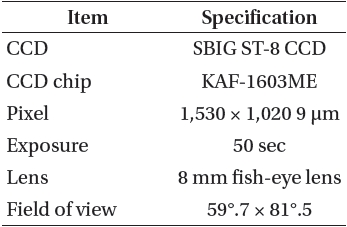
Properties of characteristics of the cloud monitoring system.
through (temperature, humidity, atmospheric pressure, wind direction and wind speed), and transfers them to the server using a FTP protocol. The cloud monitoring system measures the night skies near Polaris every fifty seconds and transfers the number of stars measured as well as their images to the server. The observation time of fifty seconds seems to be enough to maintain the star image. Because it
is important to secure a certain number of stars in case of cloud monitoring, we adopted the north-west sky including the Polaris for observing circumpolar stars. It has an advantage to minimize the CCD damage by the Sun during the daytime.
CBNUO is monitoring the weather conditions with the developed system and anyone can get the weather information in real time at our webpage (http://210.125.158.20/weather). One of the samples of our webpage is presented in Fig. 3. The measurement was performed 5 times at five sensors for humidity and temperature and the measured values are averaged for increasing the precision. The wind speed has been also measured 5 times and the maximum of the 5 values is recorded as the maximum wind speed per one minute. Fig. 4 is a sample Webpage showing the star counts measured with the cloud monitoring system.
The time variation of star counts and the time variation of the standard deviations of the measured sky images are indicated in this figure. The increasing values of the standard deviation after 14 UT is due to the influence of the Moon.
On the web page, an automatic updating carried every 90 seconds enables the observer to see the updated data by one-time run of webpage. The cloud monitoring system begins to measure at the solar altitude of -4° after sunset and ends at solar altitude of -4° before sunrise, so thus no additional attention is required (since its installation in April 2009, the abnormal termination of the computer was recorded about three times). The measured data are saved automatically in the CBNUO server, where the fits and jpeg files of measured image are stored simultaneously, and jpeg files are updated automatically on the webpage to be used as reference data for the observers. Converting of jpeg files to gif animation is also possible, which enables the observers to check the weather condition in the form of video clip.
The total number of data used in this study reaches to 2,278,173 and the daily average is 2,400, which represents
about one weather monitoring per 35 seconds. Fig. 5 shows the variations of humidity and temperature measured during day time (06:00~18:00) from 2009 to 2011. The diagrams show higher humidity during July and August while lo-wer humidity from October to May. The lowest temperature was about -25°. The local area of Munbaekmyon, Jincheon which includes the CBNUO shows to be relatively cold, when compared with near large cities. Fig. 6 presents the variations of humidity and temperature measured during night time (18:00~06:00) from 2009 to 2011. In contrast to the trend measured in day time, as shown in Fig. 5, most of the mean humidity approaches to nearly 90%, which could be partly influenced by a rivulet near the CBNUO and may be a common characteristic of most domestic countryside. Although the altitude above the sea level of CBNUO is not so high (81 m), our monitoring results show that the average temperature in January is below-zero in the day time, and -8℃ at night, showing a relatively cold distribution. Therefore it can be concluded that the best observational conditions with the lowest humidity are represented for December to June, respectively. As we can see in Fig. 6, it is very interesting that the average and minimum humidity in spring season of March, April and May was represented as lo-wer than that of fall season of September, October and November. The division of day and night was set at 06:00 assuming the lowest temperature during a day. Therefore the daytime and the night time have a same lowest temperature in our monitoring. The wind speed was excluded in this analysis because the precision of sensors and measured values was unreliable.
As can be seen in Figs. 5 and 6, the average humidity in the night time exceeds 80% in most cases which is general weather characteristics in Korea. This condition should be considered to set as the limit condition to terminate the automatic observation. We also need additional data except temperature and humidity to check whether the automatic observation is possible or not. The cloud monitoring data have been used in this purpose as follows.
2.2 Statistics of the Cloud Monitoring System
The cloud monitoring system has been used in this study as a supplement to the humidity data from the weather monitoring. Fig. 7 shows the yearly statistics of the
observable times during 2009-2011. The distributions of mean and maximum observable times and the percentages of monthly observable times are shown in this figure. Based on 3 year data, it shows that one night can be considered as a observable if more than 700 stars were maintained to be seen for 3 hours or more. The maximum number of stars since the beginning of the monitoring reaches to 3,760. One of many interesting results is the fact that the estimated number of the observable nights seems to be same to the number of actual observation nights. We could observe much more nights in January, February, March, October, and December than those of in April, May, June, July, August, September and November. In particular, in November, the number of observation nights decreases compared to October and December due to the unstable atmosphere during the season changing from fall to winter.
Fig. 8 shows the monthly distribution of the observable nights for the past 3 years (2009~2011). As expected, the observable nights for the rainy season from June to August are small. The number of the observable nights reaches to 199 and the largest number of the observable nights is in January (24 among 31 days). We conclude that more than 150 nights can be observable, although some nights are not observable due to bad condition of observation equipment. It is also to be mentioned that the observational conditions in the university observatory at local area is not comparable that those of the other national observatories (i.e. Mt. Sobaek, Mt. Bohyun and Mt. Lemmon) because of the poor man power for observation. There are many professional experts in observation at the national observatories, while it is very difficult at the university observatory to maintain the
observatory due to limited budget. CBNUO tries to secure the observation personnel and operational expenses in every way, but there are lots of difficulties.
3. STATISTICS OF PHOTOMETRIC OBSERVATION AND NUMBER OF CLEAR DAYS
In Section 2, we described that the weather and cloud monitoring should be considered together for the estimation the observable nights. The estimation of the number of observable nights and clear nights has been discussed in comparison with statistics of the photometric observation at CBNUO, where the photometric observations mainly for variable objects have been carried out since 2008. The log data of observed images are saved automatically at the server, which enables to manage the data statistics effectively. Because it takes only about 10 seconds to obtain the observation statistics from data stored in the server, one can get the yearly statistics for the observation conditions very quickly and easily with this system.
3.1 Statistics of Photometric Observation With 1 m Telescope
The log data stored in the server can be used to obtain the number of the total observing nights and average observing time. Fig. 9 shows the yearly statistics for total observing nights with the 1m reflector of the CBNUO. The number of total observing nights reaches to 113 in 2009, 113 in 2010 and 65 in 2011. The small number of the observation nights is due to troubles in CCD camera attached to the 1 m telescope. This figure shows also the average observation time of 5 hours which is similar result in Fig. 7. The distribution of observing times with the 1 m reflector at CBNUO from March, 2009 to June, 2011 is shown in Fig. 10. Daily observation time was recorded as about 10 hours, and the actual maximum observation time was represented as 13 hours and 20 minutes. In July, 2009, no observation was performed due to troubles of right ascension encoder in the rainy season (two months break-down of the telescope), and in September 2010, the observations were not performed due to troubles of 2 K CCD which is the main instrument. Thereafter, we attached 150 mm refracting telescope and ST-8 CCD to our 1 m telescope mount, and the variable stars brighter than 8th magnitude have been observed. We have no observation data June 2011 due to troubles of ST-8 CCD. The observation strategy of CBNUO is to get a full light curve from the observation for 30~60 days continuously for one target. As can be seen in Fig. 11, many targets have been observed as many as possible in maximum of 150 days. We observed one target continuously until it is possible. This strategy has an advantage particularly for long period variables compared to the other observatories where they cannot afford such longtime base observations.
3.2 Statistics of Photometric Observation With 0.6 m Telescope
We participated in a research project for NEOPAT performed by KASI (Yim et al. 2009), and as a result, in November 2010, we installed a 0.6 m wide field telescope developed by the KASI for experimental observation at CBNUO site provisionally, allowing us independent, or simultaneous observations using these two telescopes. Because of different timings obtaining flat images for 1 m and 0.6 m telescope, one observer can carry the observation simultaneously. Fig. 12 shows the yearly statistics of observations with the 0.6 m wide view reflector, while Fig. 13 shows the distribution of the observation times with the 0.6 m telescope from November 2010 to December 2011. Total number of observation nights reaches to 143 showing a similar tendency expected in the cloud monitoring system (150), and also the observation time was more than average 5 hours as shown in Fig. 7. Our observation system indicates no system problems from its installation in November 2010 to November 2011, and the results of the photometric studies will be published elsewhere.
The main purpose of the 0.6 m wide view reflector is to observe the near earth objects using its wide viewing angle. It’s maximum driving speed is 30°/s. Fig. 14 shows the number of observing nights for some program stars observed with the 0.6 m reflector. Most of the program stars
are variable stars with some exception such as a comet (147P/Kushida-Muramatsu) and a minor planet (1906ua).
In addition to such observation, artificial satellites (Jin et al. 2011) have been also observed. Some special observation can be carried out in the future if it is requested by other institutes. It is also planned to install 4 K-class CCD (current viewing angle: 27′ × 18′, max viewing angle: 2° × 2°, viewing angle with the 4 K-class CCD: 78′ × 78′) in order to increase the efficiency of the observation.
In this study, we have analyzed the data from the weather monitoring system developed by CBNUO. The results show that the average number of the observable nights for a year reaches to about 140 days and the average observation time reaches to about 5 hours. The humidity in CBNUO shows relatively low in October to April while the high humidity from May to September disturbs the observation. The average temperature from December to February is below zero, and the coldest temperature were recorded as -25℃. In addition, the cloud monitoring system has been also used to estimate the observable nights. We count the observable days based on the definition that the observable night is a night when more than 700 stars were maintained to be seen for about 3 hours in the cloud monitoring system. The maximum number of the observable nights of CBNUO reaches to 199, and we have more than 20 observable nights on January, October and December.
The number of observable nights from the data of the weather and cloud monitoring system has been estimated and compared to the actual nights when observations were performed. The estimated number is similar to the actual observation nights. It is therefore concluded that the cloud monitoring system can be used with the fundamental weather monitoring purposes in order to estimate the number of observable nights more accurately.
It is advisable to install the weather and cloud monitoring system at observatories in Korea equipped with the telescope larger than 0.6 m and the automatic observation systems for research purposes. The weather monitoring system would be helpful to enhance observational research activities in Korea as well as public outreach in the future.
